Biomass Fly Ash Self-Hardened Adsorbent Monoliths for Methylene Blue Removal from Aqueous Solutions
Abstract
:Featured Application
Abstract
1. Introduction
2. Materials and Methods
2.1. Materials
2.2. Preparation of the Self-Hardened Monoliths
2.3. Raw Materials and Self-Hardened Monoliths Characterization
2.4. MB Adsorption Experiments
2.4.1. MB Uptake and Removal Efficiency
2.4.2. Isotherm Models
2.4.3. Adsorption Kinetics
3. Results and Discussion
3.1. Raw Materials Characterization
3.2. Monoliths Characterization
3.3. MB Adsorption Tests
3.3.1. Influence of MB Initial Concentration
3.3.2. Influence of Contact Time
3.3.3. Adsorption Isotherm Model Studies
3.3.4. Adsorption Kinetics Studies
3.3.5. Comparison with Other Studies
4. Conclusions
Author Contributions
Funding
Institutional Review Board Statement
Informed Consent Statement
Data Availability Statement
Conflicts of Interest
References
- Leflaivei, X.; Witmer, M.; Martin-Hurtado, R.; Bakker, M.; Kram, T.; Bouwman, L.; Visser, H.; Bouwman, A.; Hilderink, H.; Kayoung, K. “Water” in OECD Environmental Outlook to 2050: The Consequences of Inaction; OECD Publishing: Paris, France, 2012. [Google Scholar] [CrossRef]
- Novais, R.M.; Carvalheiras, J.; Tobaldi, D.M.; Seabra, M.P.; Pullar, R.C.; Labrincha, J.A. Synthesis of porous biomass fly ash-based geopolymer spheres for efficient removal of methylene blue from wastewaters. J. Clean. Prod. 2019, 207, 350–362. [Google Scholar] [CrossRef]
- Rafatullah, M.; Sulaiman, O.; Hashim, R.; Ahmad, A. Adsorption of methylene blue on low-cost adsorbents: A review. J. Hazard. Mater. 2010, 177, 70–80. [Google Scholar] [CrossRef] [PubMed]
- Novais, R.M.; Ascensão, G.; Tobaldi, D.M.; Seabra, M.P.; Labrincha, J.A. Biomass fly ash geopolymer monoliths for effective methylene blue removal from wastewaters. J. Clean. Prod. 2018, 171, 783–794. [Google Scholar] [CrossRef]
- Illikainen, M.; Tanskanen, P.; Kinnunen, P.; Körkkö, M.; Peltosaari, O.; Wigren, V.; Österbacka, J.; Talling, B.; Niinimäki, J. Reactivity and self-hardening of fly ash from the fluidized bed combustion of wood and peat. Fuel 2014, 135, 69–75. [Google Scholar] [CrossRef]
- Ohenoja, K.; Tanskanen, P.; Wigren, V.; Kinnunen, P.; Körkkö, M.; Peltosaari, O.; Österbacka, J.; Illikainen, M. Self-hardening of fly ashes from a bubbling fluidized bed combustion of peat, forest industry residuals, and wastes. Fuel 2016, 165, 440–446. [Google Scholar] [CrossRef]
- Ohenoja, K.; Tanskanen, P.; Peltosaari, O.; Wigren, V.; Österbacka, J.; Illikainen, M. Effect of particle size distribution on the self-hardening property of biomass-peat fly ash from a bubbling fluidized bed combustion. Fuel Process. Technol. 2016, 148, 60–66. [Google Scholar] [CrossRef]
- Sigvardsen, N.M.; Geiker, M.R.; Ottosen, L.M. Reaction mechanisms of wood ash for use as a partial cement replacement. Constr. Build. Mater. 2021, 286, 122889. [Google Scholar] [CrossRef]
- European Commission. A Roadmap for Moving to a Competitive Low Carbon Economy in 2050. 2011. Available online: http://eur-lex.europa.eu/LexUriServ/LexUriServ.do?uri=COM:2011:0112:FIN:EN:PDF (accessed on 13 April 2021).
- Tarelho, L.A.C.; Teixeira, E.R.; Silva, D.F.R.; Modolo, R.C.E.; Labrincha, J.A.; Rocha, F. Characteristics of distinct ash flows in a biomass thermal power plant with bubbling fluidised bed combustor. Energy 2015, 90, 387–402. [Google Scholar] [CrossRef]
- Novais, R.M.; Ascensão, G.; Ferreira, N.; Seabra, M.P.; Labrincha, J.A. Influence of water and aluminium powder content on the properties of waste-containing geopolymer foams. Ceram. Int. 2018, 44, 6242–6249. [Google Scholar] [CrossRef]
- Hertel, T.; Novais, R.M.; Alarcón, R.M.; Labrincha, J.A.; Pontikes, Y. Use of modified bauxite residue-based porous inorganic polymer monoliths as adsorbents of methylene blue. J. Clean. Prod. 2019, 227, 877–889. [Google Scholar] [CrossRef]
- Janoš, P.; Buchtová, H.; Rýznarová, M. Sorption of dyes from aqueous solutions onto fly ash. Water Res. 2003, 37, 4938–4944. [Google Scholar] [CrossRef] [PubMed]
- Kumar, K.V.; Sivanesan, S. Isotherms for Malachite Green onto rubber wood (Hevea brasiliensis) sawdust: Comparison of linear and non-linear methods. Dye. Pigment. 2007, 72, 124–129. [Google Scholar] [CrossRef]
- Ayawei, N.; Ebelegi, A.N.; Wankasi, D. Modelling and Interpretation of Adsorption Isotherms. J. Chem. 2017, 2017, 3039817. [Google Scholar] [CrossRef]
- Kumar, K.V.; Ramamurthi, V.; Sivanesan, S. Modeling the mechanism involved during the sorption of methylene blue onto fly ash. J. Colloid Interface Sci. 2005, 284, 14–21. [Google Scholar] [CrossRef] [PubMed]
- Singh, V.P.; Vaish, R. Cement-based diesel exhaust emission soot coatings for the removal of organic pollutants from water. Constr. Build. Mater. 2020, 234, 117377. [Google Scholar] [CrossRef]
- El Alouani, M.; Alehyen, S.; el Achouri, M.; Taibi, M. Comparative study of the adsorption of micropollutant contained in aqueous phase using coal fly ash and activated coal fly ash: Kinetic and isotherm studies. Chem. Data Collect. 2019, 23, 100265. [Google Scholar] [CrossRef]
- Rajamma, R.; Senff, L.; Ribeiro, M.J.; Labrincha, J.A.; Ball, R.J.; Allen, G.C.; Ferreira, V.M. Biomass fly ash effect on fresh and hardened state properties of cement based materials. Compos. Part B Eng. 2015, 77, 1–9. [Google Scholar] [CrossRef]
- Ohenoja, K.; Pesonen, J.; Yliniemi, J.; Illikainen, M. Utilization of fly ashes from fluidized bed combustion: A review. Sustainability 2020, 12, 2988. [Google Scholar] [CrossRef] [Green Version]
- EN 197-1:2011; Cement Part 1: Composition, Specifications and Conformity Criteria for Common Cements. CEN: Brussels, Belgium, 2011.
- Huang, J.; Koroteev, D.D.; Zhang, M. Smartphone-based study of cement-activated charcoal coatings for removal of organic pollutants from water. Constr. Build. Mater. 2021, 300, 124034. [Google Scholar] [CrossRef]
- Woolard, C.D.; Strong, J.; Erasmus, C.R. Evaluation of the use of modified coal ash as a potential sorbent for organic waste streams. Appl. Geochem. 2002, 17, 1159–1164. [Google Scholar] [CrossRef]
- Gupta, V.K.; Mohan, D.; Sharma, S.; Sharma, M. Removal of basic dyes (rhodamine B and methylene blue) from aqueous solutions using bagasse fly ash. Sep. Sci. Technol. 2000, 35, 2097–2113. [Google Scholar] [CrossRef]
- Wang, S.; Boyjoo, Y.; Choueib, A. A comparative study of dye removal using fly ash treated by different methods. Chemosphere 2005, 60, 1401–1407. [Google Scholar] [CrossRef] [PubMed]
- Zhang, Y.; Liu, L. Fly ash-based geopolymer as a novel photocatalyst for degradation of dye from wastewater. Particuology 2013, 11, 353–358. [Google Scholar] [CrossRef]
- Berra, M.; Mangialardi, T.; Paolini, A.E. Reuse of woody biomass fly ash in cement-based materials. Constr. Build. Mater. 2015, 76, 286–296. [Google Scholar] [CrossRef]
- Cuenca, J.; Rodríguez, J.; Martín-Morales, M.; Sánchez-Roldán, Z.; Zamorano, M. Effects of olive residue biomass fly ash as filler in self-compacting concrete. Constr. Build. Mater. 2013, 40, 702–709. [Google Scholar] [CrossRef]
- Modolo, R.C.E.; Senff, L.; Ferreira, V.M.; Tarelho, L.A.C.; Moraes, C.A.M. Fly ash from biomass combustion as replacement raw material and its influence on the mortars durability. J. Mater. Cycles Waste Manag. 2018, 20, 1006–1015. [Google Scholar] [CrossRef]

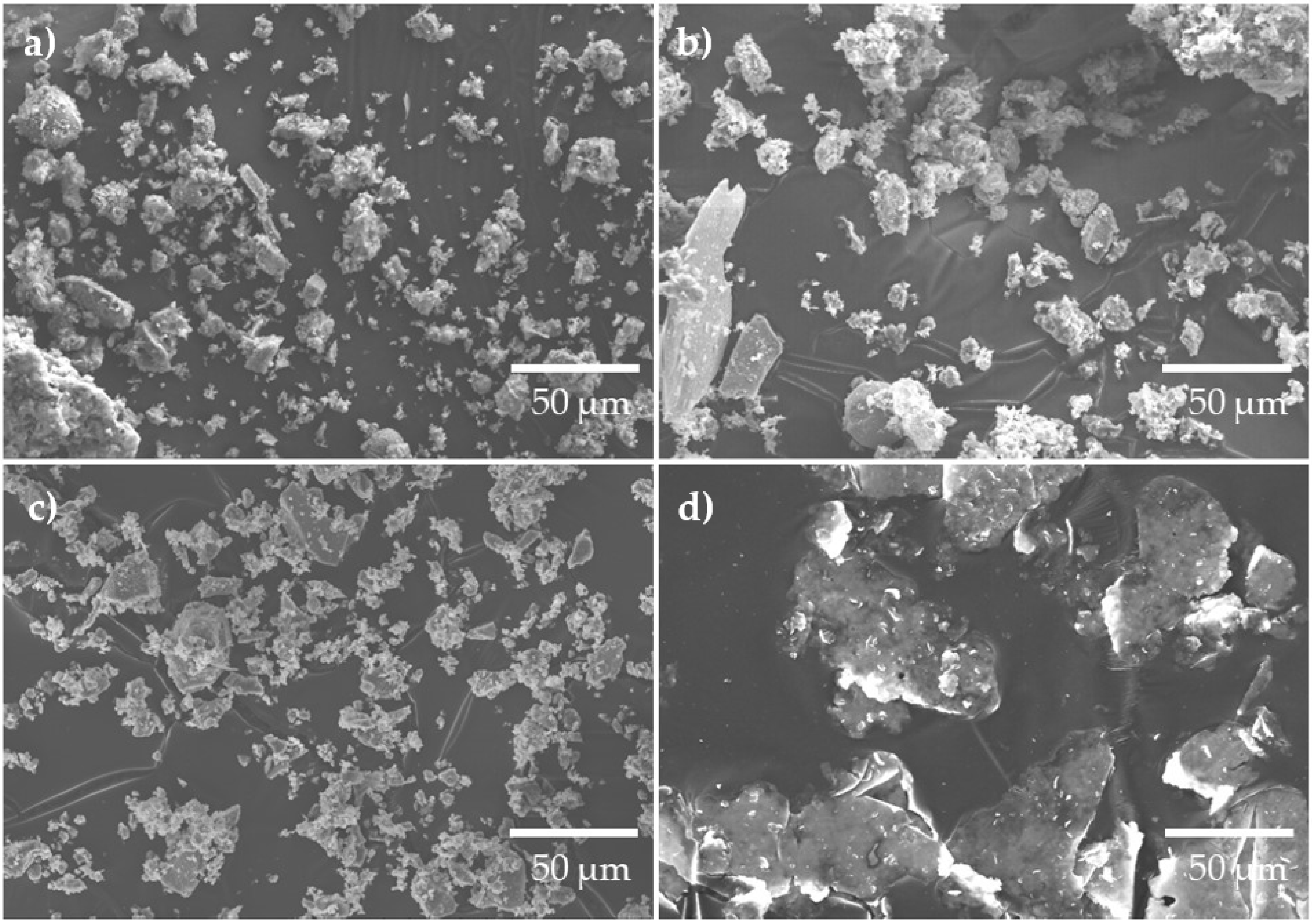
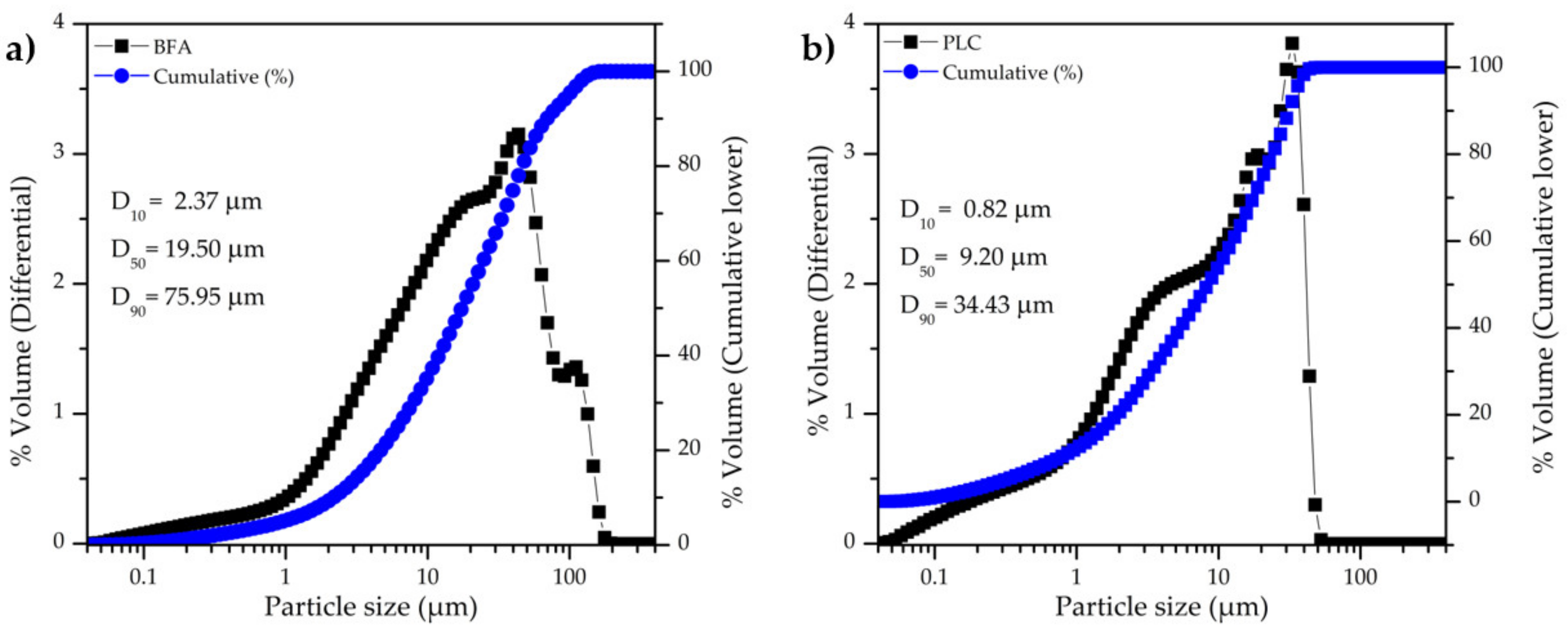
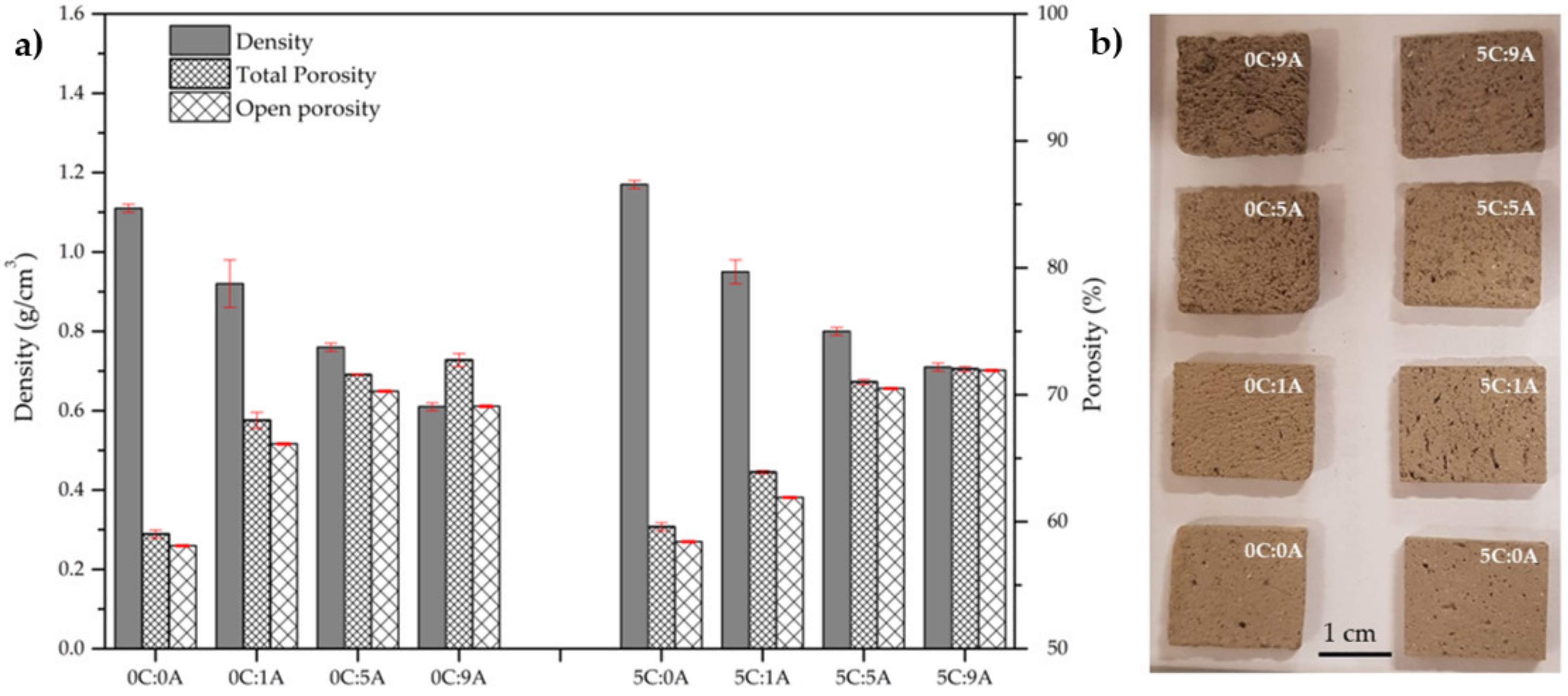
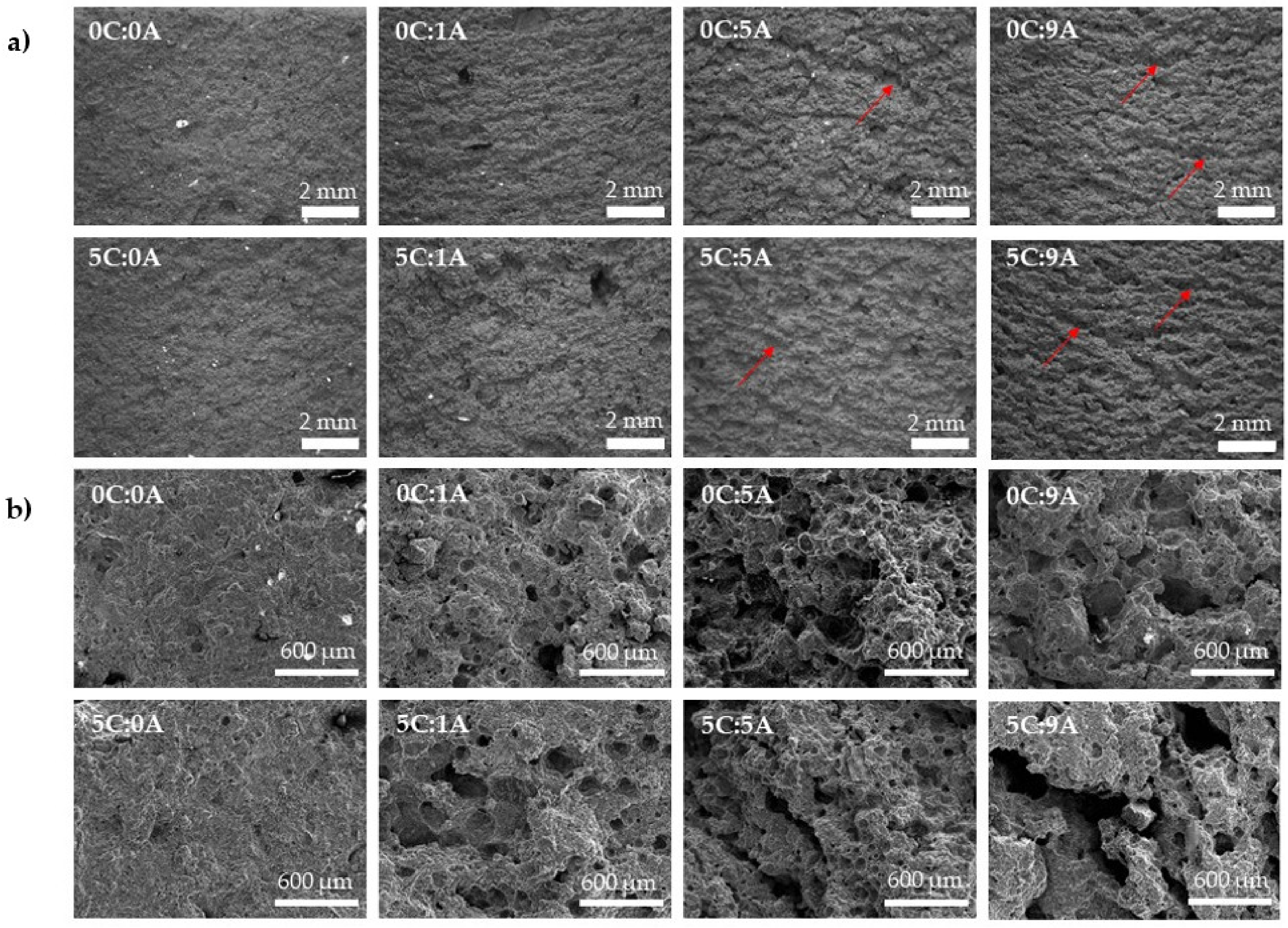



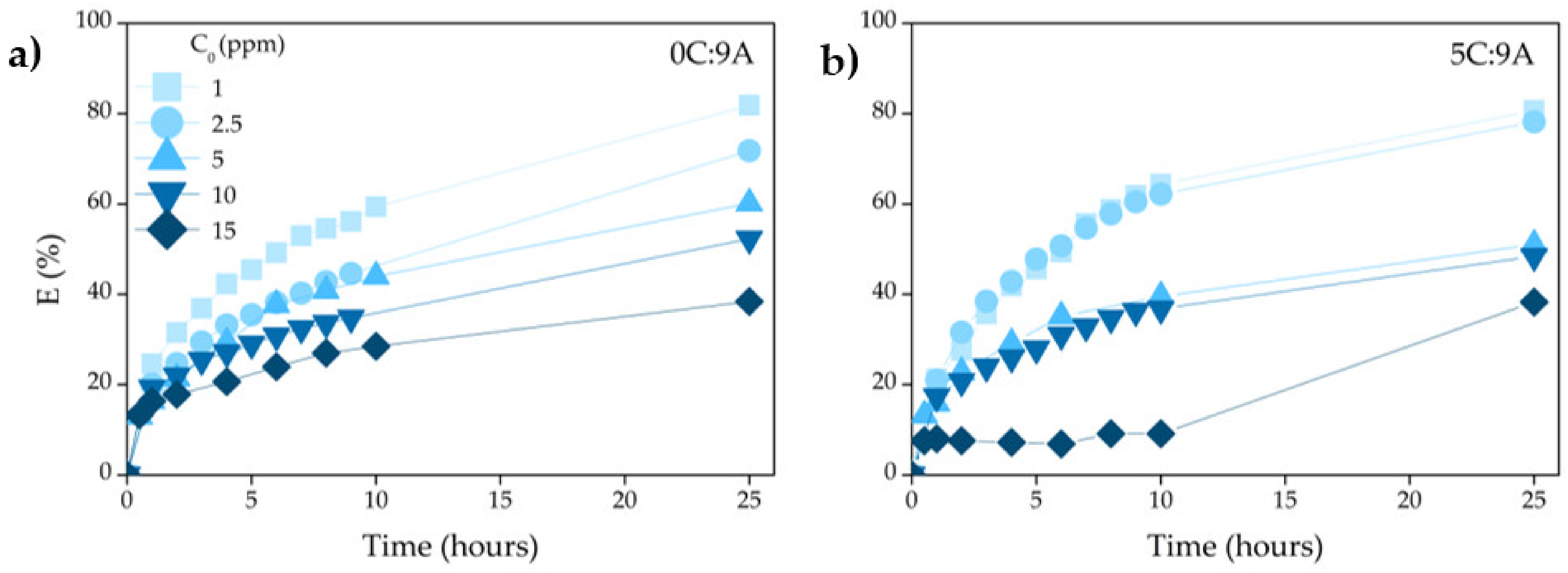
| Slurries | Raw Materials (g) | ||||
|---|---|---|---|---|---|
| Water | BFA | PLC | AP | Surfactant | |
| 0C:0A | 42 | 100 | 0 | 0.00 | 0.00 |
| 0C:1A | 42 | 100 | 0 | 0.01 | 0.05 |
| 0C:5A | 42 | 100 | 0 | 0.05 | 0.05 |
| 0C:9A | 42 | 100 | 0 | 0.09 | 0.05 |
| 5C:0A | 42 | 95 | 5 | 0.00 | 0.00 |
| 5C:1A | 42 | 95 | 5 | 0.01 | 0.05 |
| 5C:5A | 42 | 95 | 5 | 0.05 | 0.05 |
| 5C:9A | 42 | 95 | 5 | 0.09 | 0.05 |
| Compounds (wt.%) | BFA | PLC |
|---|---|---|
| CaO | 32.3 | 73.1 |
| SiO2 | 21.8 | 13.0 |
| K2O | 9.28 | 1.69 |
| Al2O3 | 8.74 | 2.78 |
| Cl | 6.21 | 0.13 |
| Na2O | 6.04 | 0.35 |
| MgO | 4.40 | 1.53 |
| Fe2O3 | 4.40 | 2.94 |
| SO3 | 3.74 | 4.02 |
| P2O5 | 1.30 | 0.18 |
| MnO | 0.91 | 0.04 |
| TiO2 | 0.55 | 0.16 |
| CaO/SiO2 | 1.48 | 5.62 |
| (CaO + MgO)/SiO2 | 1.68 | 5.74 |
| LOI | 10.48 | 16.41 |
| Samples | ||||||||
|---|---|---|---|---|---|---|---|---|
| 0C:0A | 0C:1A | 0C:5A | 0C:9A | 5C:0A | 5C:1A | 5C:5A | 5C:9A | |
| (mg/g) | 0.302 | 0.360 | 0.426 | 0.623 | 0.219 | 0.312 | 0.371 | 0.657 |
| (L/mg) | 0.351 | 0.475 | 0.956 | 1.305 | 0.540 | 0.408 | 0.965 | 0.849 |
| R2 | 0.991 | 0.971 | 0.952 | 0.989 | 0.979 | 0.999 | 0.989 | 0.966 |
| 1 ppm | 0.735 | 0.672 | 0.504 | 0.427 | 0.642 | 0.704 | 0.502 | 0.533 |
| 2.5 ppm | 0.523 | 0.448 | 0.287 | 0.228 | 0.416 | 0.485 | 0.285 | 0.312 |
| 5 ppm | 0.365 | 0.299 | 0.174 | 0.134 | 0.272 | 0.331 | 0.173 | 0.192 |
| 10 ppm | 0.235 | 0.185 | 0.101 | 0.076 | 0.167 | 0.209 | 0.101 | 0.113 |
| 15 ppm | 0.165 | 0.127 | 0.068 | 0.050 | 0.114 | 0.145 | 0.067 | 0.075 |
| Samples | ||||||||
|---|---|---|---|---|---|---|---|---|
| 0C:0A | 0C:1A | 0C:5A | 0C:9A | 5C:0A | 5C:1A | 5C:5A | 5C:9A | |
| mg1−1/n g−1L1/n) | 0.072 | 0.103 | 0.161 | 0.261 | 0.068 | 0.080 | 0.150 | 0.239 |
| n | 1.70 | 1.71 | 1.86 | 2.14 | 1.87 | 1.91 | 2.42 | 2.16 |
| R2 | 0.977 | 0.930 | 0.935 | 0.981 | 0.982 | 0.925 | 0.841 | 0.887 |
| Samples | Pseudo-First-Order | Pseudo-Second-Order | ||||||
|---|---|---|---|---|---|---|---|---|
| R12 | R22 | |||||||
| 0C:0A | 1 | 0.04 | 0.034 | 0.00138 | 0.996 | 0.051 | 0.05027 | 0.943 |
| 2.5 | 0.08 | 0.053 | 0.00138 | 0.970 | 0.094 | 0.04301 | 0.964 | |
| 5 | 0.16 | 0.115 | 0.00161 | 0.968 | 0.176 | 0.02774 | 0.963 | |
| 10 | 0.20 | 0.133 | 0.00161 | 0.944 | 0.220 | 0.01761 | 0.969 | |
| 15 | 0.30 | 0.281 | 0.00005 | 0.741 | 0.975 | 0.00021 | 0.042 | |
| 0C:1A | 1 | 0.06 | 0.044 | 0.00161 | 0.970 | 0.068 | 0.04673 | 0.971 |
| 2.5 | 0.12 | 0.092 | 0.00138 | 0.997 | 0.143 | 0.01865 | 0.941 | |
| 5 | 0.17 | 0.130 | 0.00184 | 0.996 | 0.187 | 0.02396 | 0.970 | |
| 10 | 0.38 | 0.292 | 0.00230 | 0.990 | 0.434 | 0.01046 | 0.994 | |
| 15 | 0.34 | 0.304 | 0.00046 | 0.671 | 0.511 | 0.00125 | 0.163 | |
| 0C:5A | 1 | 0.08 | 0.061 | 0.00138 | 0.995 | 0.093 | 0.03062 | 0.954 |
| 2.5 | 0.16 | 0.118 | 0.00161 | 0.993 | 0.181 | 0.01828 | 0.978 | |
| 5 | 0.22 | 0.156 | 0.00230 | 0.955 | 0.234 | 0.02840 | 0.992 | |
| 10 | 0.40 | 0.308 | 0.00230 | 0.982 | 0.454 | 0.00901 | 0.996 | |
| 15 | 0.66 | 0.615 | 0.00115 | 0.966 | 1.123 | 0.00079 | 0.619 | |
| 0C:9A | 1 | 0.12 | 0.091 | 0.00161 | 0.992 | 0.140 | 0.02451 | 0.976 |
| 2.5 | 0.21 | 0.157 | 0.00138 | 0.994 | 0.245 | 0.01057 | 0.943 | |
| 5 | 0.37 | 0.298 | 0.00184 | 0.990 | 0.413 | 0.00976 | 0.977 | |
| 10 | 0.60 | 0.400 | 0.00138 | 0.993 | 0.674 | 0.00543 | 0.960 | |
| 15 | 0.66 | 0.435 | 0.00161 | 0.992 | 0.702 | 0.00814 | 0.971 | |
| 5C:0A | 1 | 0.04 | 0.033 | 0.00161 | 0.978 | 0.051 | 0.06191 | 0.975 |
| 2.5 | 0.09 | 0.066 | 0.00161 | 0.977 | 0.100 | 0.03267 | 0.954 | |
| 5 | 0.13 | 0.100 | 0.00138 | 0.975 | 0.147 | 0.02479 | 0.928 | |
| 10 | 0.17 | 0.129 | 0.00138 | 0.992 | 0.198 | 0.01302 | 0.948 | |
| 15 | 0.27 | 0.236 | 0.00014 | 0.106 | 0.515 | 0.00042 | 0.005 | |
| 5C:1A | 1 | 0.04 | 0.043 | 0.00161 | 0.995 | 0.064 | 0.02164 | 0.947 |
| 2.5 | 0.18 | 0.148 | 0.00161 | 0.995 | 0.215 | 0.01435 | 0.968 | |
| 5 | 0.18 | 0.137 | 0.00161 | 0.983 | 0.201 | 0.02187 | 0.957 | |
| 10 | 0.24 | 0.185 | 0.00161 | 0.986 | 0.282 | 0.00987 | 0.959 | |
| 15 | 0.23 | 0.164 | 0.00046 | 0.577 | 0.272 | 0.00378 | 0.188 | |
| 5C:5A | 1 | 0.06 | 0.055 | 0.00207 | 0.999 | 0.077 | 0.03462 | 0.989 |
| 2.5 | 0.20 | 0.156 | 0.00161 | 0.994 | 0.230 | 0.01324 | 0.959 | |
| 5 | 0.23 | 0.171 | 0.00161 | 0.960 | 0.252 | 0.01745 | 0.962 | |
| 10 | 0.38 | 0.312 | 0.00138 | 0.997 | 0.470 | 0.00464 | 0.939 | |
| 15 | 0.30 | 0.257 | 0.00023 | 0.321 | 2.429 | 0.00003 | 0.002 | |
| 5C:9A | 1 | 0.08 | 0.070 | 0.00253 | 0.997 | 0.096 | 0.03551 | 0.993 |
| 2.5 | 0.27 | 0.221 | 0.00230 | 0.996 | 0.311 | 0.01391 | 0.992 | |
| 5 | 0.31 | 0.228 | 0.00207 | 0.975 | 0.338 | 0.02200 | 0.915 | |
| 10 | 0.52 | 0.377 | 0.00184 | 0.997 | 0.584 | 0.00709 | 0.984 | |
| 15 | 0.62 | 0.504 | 0.00007 | 0.354 | 0.768 | 0.00116 | 0.236 | |
| Material | Adsorbent Shape | Ref. | |
|---|---|---|---|
| CFA NaOH hydrothermally treated | Powder | 10.82 | [23] |
| BFA H2O2 heat-treated and sieved | Powder | 6.46 | [3,24] |
| CFA grounded | Powder | 6.04 | [3,13] |
| CFA washed | Powder | 5.72 | [16] |
| CFA unmodified | Powder | 2.97 | [25] |
| CFA unmodified | Powder | 2.88 | [18] |
| CFA microwave heated in HCl solution | Powder | 2.78 | [25] |
| CFA sonicated in HCl solution | Powder | 2.58 | [25] |
| BFA-based geopolymer | Cylindrical monolith | 2.40 1 | [4] |
| CFA ground and sieved | Powder (<90 µm) | 1.47 | [3,13] |
| CFA | powder | 1.11 | [3,23] |
| CFA based geopolymer | powder | 0.67 | [2,26] |
| BFA based self-hardened | Parallelepiped monolith | 0.62 | This work |
Publisher’s Note: MDPI stays neutral with regard to jurisdictional claims in published maps and institutional affiliations. |
© 2022 by the authors. Licensee MDPI, Basel, Switzerland. This article is an open access article distributed under the terms and conditions of the Creative Commons Attribution (CC BY) license (https://creativecommons.org/licenses/by/4.0/).
Share and Cite
Capela, M.N.; Cesconeto, F.R.; Pinto, P.C.; Tarelho, L.A.C.; Seabra, M.P.; Labrincha, J.A. Biomass Fly Ash Self-Hardened Adsorbent Monoliths for Methylene Blue Removal from Aqueous Solutions. Appl. Sci. 2022, 12, 5134. https://doi.org/10.3390/app12105134
Capela MN, Cesconeto FR, Pinto PC, Tarelho LAC, Seabra MP, Labrincha JA. Biomass Fly Ash Self-Hardened Adsorbent Monoliths for Methylene Blue Removal from Aqueous Solutions. Applied Sciences. 2022; 12(10):5134. https://doi.org/10.3390/app12105134
Chicago/Turabian StyleCapela, Marinélia N., Francielly R. Cesconeto, Paula C. Pinto, Luís A. C. Tarelho, Maria P. Seabra, and João A. Labrincha. 2022. "Biomass Fly Ash Self-Hardened Adsorbent Monoliths for Methylene Blue Removal from Aqueous Solutions" Applied Sciences 12, no. 10: 5134. https://doi.org/10.3390/app12105134
APA StyleCapela, M. N., Cesconeto, F. R., Pinto, P. C., Tarelho, L. A. C., Seabra, M. P., & Labrincha, J. A. (2022). Biomass Fly Ash Self-Hardened Adsorbent Monoliths for Methylene Blue Removal from Aqueous Solutions. Applied Sciences, 12(10), 5134. https://doi.org/10.3390/app12105134







